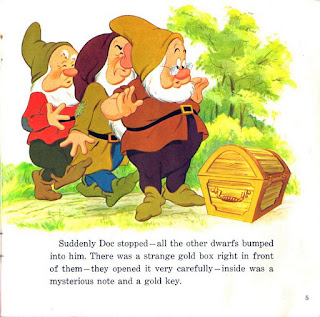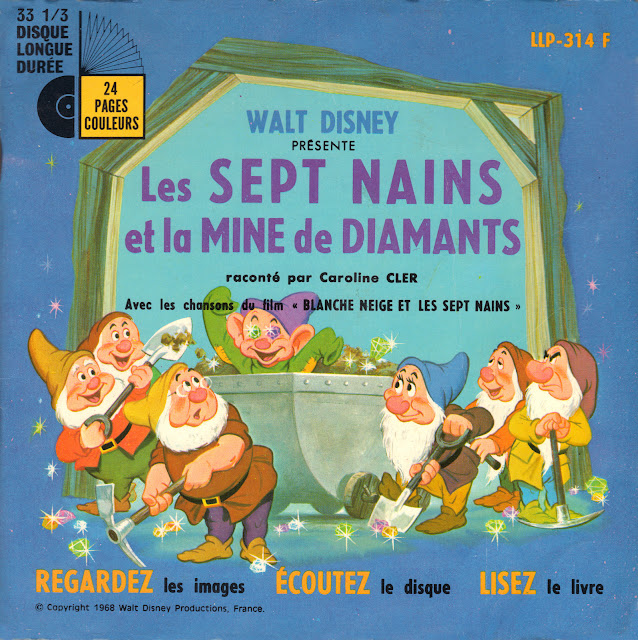In the previous post, we took a look at Disneyland Records #DL-1297, Walt Disney's Story of the Seven Dwarfs and their Diamond Mine. It was released in 1966 as a 33⅓ LP 12" disc. The following year in 1967, album #LLP-314 was introduced with the same title but as part of the See, Hear, Read series. It was issued as a 7" LP and included a 24 page read-along book (Western Publishing Company).
Illustration Artwork and Audio Excerpts copyright Disney. Re-posted here for Educational and Historical Documentation purposes only.
This North American See, Hear, Read edition contained the same narrative recording (by "Disneyland Story Reader" Robie Lester) as the 1966 version but in an abbreviated, edited form. It also introduced the Tinker Bell chime to let young readers know when it was time to turn the page in their book. The two deleted songs from the film, "Music in Your Soup" and "You're Never Too Old To Be Young" were also here but no longer integrated into the story. Side 1 narrative; Side 2 songs.
Original release on green disc labels; later pressings used the "yellow rainbow" labels.
_____
The Hobbit:
What was the See, Hear, Read story? The Seven Dwarfs set out from their cottage and end up following clues along the way until they make a marvelous discovery. It's merely coincidental that Walt Disney's Snow White and the Seven Dwarfs and J.R.R. Tolkien's The Hobbit were both first released in 1937. What might not be so accidental is the fact that this Diamond Mine story has a number of similar plot elements that can also be found in Tolkien's novel. His book was fresh off a re-printing in 1966, the same year this Disney audio story first came out. Let's look a little closer.
One of the motivating forces in The Hobbit is the idea that at the end of the dwarves' long journey to the Lonely Mountain, there is a hidden doorway that will lead them to a mysterious passage and the treasure. The secrets of this magical doorway are revealed (with the help of Gandalf and Elrond) by way of notations on a map and letters that can only be read by light of the midsummer moon. After many trials, the dwarves finally reach the appointed spot. It's the autumnal equinox, and here they wait until the last rays of sunlight hit the stone wall behind them. At that precise moment, a door appears and a key must be used to open it before the moment passes. They go in, and (after more trials and the climax of the book) those that remain finally get their treasure.
The Seven Dwarfs and Their Diamond Mine takes place after the film, and Snow White has been happily married for two years. Comparing a complex and intricate story like The Hobbit to a simple See, Hear, Read tale seems rather silly; nonetheless, it's fun! So our Seven Dwarfs do indeed discover a mysterious note and a gold key. Clues about midnight, moonlight, and a secret door are provided. When the grandfather clock in their mine strikes twelve, "a moonbeam came through the cave roof and shone on a door that had never been there before." Grumpy quickly puts the key in and opens the door to reveal a secret passage...to a royal ballroom where Snow White awaits their arrival.
______
Listen:
Hear a brief excerpt from the story here...
And listen to the entire tale at MouseVinyl.
______
The Book:
Page 1...
Page 5-6...
Page 12-13...
Page 16-17...
Page 20...
Page 22-23...
______
French Release:
The same story, Les Sept Nains et la Mine de Diamants, was produced in France in 1968. Series #LLP-314 F. Narrated by Caroline Cler. Story on Side 1; songs on Side 2.
The two songs "Music in Your Soup" and "You're Never Too Old To Be Young" were not included on the record. This is probably due to the fact that there was never a need to dub the lyrics into other languages since they weren't used in the final film. The four songs on Side 2 are not from the original French film soundtrack but are all commercial re-recordings, often used in various storybooks like this one.
A brief excerpt from the story in French...
Front endpaper and page 1...
Page 18...
Page 19...
The French lyrics printed at the end don't exactly match the ones heard in the film...
French album scans and info courtesy of Greg Philip at A Lost Film.
______
UK Release:
A 1968 album was also released in the United Kingdom. Note the copyright date in the lower left-hand corner differs from the 1967 US version.
The copyright notations on the front endpaper of the book also differ...
The disc labels are blue with fine pint around the edge that reads, "Made in Great Britain and sold in the UK."
The two deleted songs are back on Side B which is copyrighted 1967...
Side A is dated 1968 because the track was re-recorded. As with the French version, the UK story is narrated by a native speaker, this one being Disneyland Story Reader Jean Aubrey...
UK album images via paris-accent.





























Tidak ada komentar:
Posting Komentar